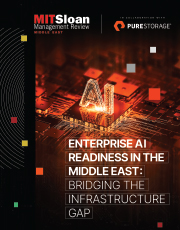Enterprise AI Readiness in the Middle East: Bridging the Infrastructure Gap
This white paper emphasizes the critical role that modern data architectures play in enabling scalable, efficient, and enterprise-wide AI adoption.
MITSloan ME Editorial
Reading Time: 5 min
Topics
MIT SMR CONNECTIONS
At MIT SMR Connections we explore the latest trends on leadership, managing technology, and digital transformation.
More in this series
News
- Andrej Karpathy Says AI Agents Are Not There Yet
- UAE 9th Globally in Cyber Impact; Iran Targets Israel Most Frequently
- Sheikh Hamdan Approves New AI Initiatives to Strengthen Dubai’s Digital Future
- Anthropic Says AI Now Writes 90% of Its Code
- Space42 Signs MoU With e& For V2X technologies
- Instagram Tightens Teen Controls Amid Safety Scrutiny

[Image source: Chetan Jha/MITSMR Middle East]





